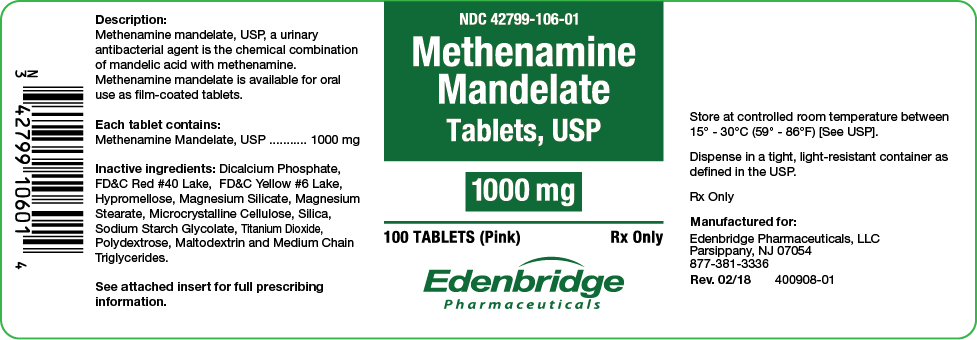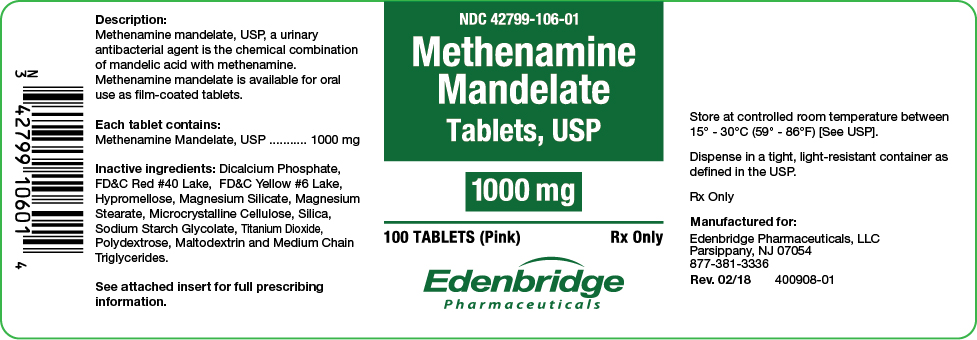Label: METHENAMINE MANDELATE tablet
- NDC Code(s): 42799-105-01, 42799-105-99, 42799-106-01, 42799-106-99
- Packager: Edenbridge Pharmaceuticals LLC.
- Category: HUMAN PRESCRIPTION DRUG LABEL
- DEA Schedule: None
- Marketing Status: unapproved drug other
DISCLAIMER: This drug has not been found by FDA to be safe and effective, and this labeling has not been approved by FDA. For further information about unapproved drugs, click here.
Drug Label Information
Updated November 8, 2021
If you are a consumer or patient please visit this version.
- Download DRUG LABEL INFO: PDF XML
- Official Label (Printer Friendly)
-
DESCRIPTION:
Methenamine mandelate, USP, a urinary antibacterial agent, is the chemical combination of mandelic acid with methenamine. Methenamine mandelate, USP is available for oral use as film-coated tablets.
Active Ingredients:
Methenamine Mandelate: 500 mg or 0.5 gm.
Methenamine Mandelate: 1000 mg or 1.0 gm.Other Ingredients: Dicalcium Phosphate, FD and C Blue #1 Lake, FD and C Red #40 Lake, FD and C Yellow #6 Lake, Hypromellose, Magnesium Silicate, Magnesium Stearate, Microcrystalline Cellulose, Silica, Sodium Starch Glycolate, Titanium Dioxide, Polydextrose, Maltodextrin, and Medium Chain Triglycercides.
-
CLINICAL PHARMACOLOGY
Methenamine mandelate, USP is readily absorbed but remains essentially inactive until it is excreted by the kidney and concentrated in the urine. An acid urine is essential for antibacterial action, with maximum efficacy occurring at pH 5.5 or less. In an acid urine, mandelic acid exerts its antibacterial action and also contributes to the acidification of the urine. Mandelic acid is excreted both by glomerular filtration and tubular excretion. The methenamine component, in an acid urine, is hydrolyzed to ammonia and to the bactericidal agent formaldehyde. There is equally effective antibacterial activity against both gram-positive and gram-negative organisms, since the antibacterial action of mandelic acid and formaldehyde is nonspecific. There are reports that methenamine mandelate, USP is ineffective in some infections with Proteus vulgaris and urea-splitting strains of Pseudomonas aeruginosa and A aerogenes. Since urea-splitting strains may raise the pH of the urine, particular attention to supplementary acidification is required. However, results in any single case will depend to a large extent on the underlying pathology and the overall management.
-
INDICATIONS AND USAGE
Methenamine mandelate, USP is indicated for the suppression or elimination of bacteriuria associated with pyelonephritis, cystitis, and other chronic urinary tract infections; also for infected residual urine sometimes accompanying neurologic diseases. When used as recommended, methenamine mandelate, USP is particularly suitable for long-term therapy because of its safety and because resistance to the nonspecific bactericidal action of formaldehyde does not develop. Pathogens resistant to other antibacterial agents may respond to methenamine mandelate, USP because of the nonspecific effect of formaldehyde formed in an acid urine.
Prophylactic Use Rationale: Urine is a good culture medium for many urinary pathogens. Inoculation by a few organisms (relapse or reinfection) may lead to bacteriuria in susceptible individuals. Thus, the rationale of management in recurring urinary tract infection (bacteriuria) is to change the urine from a growth-supporting to a growth-inhibiting medium. There is a growing body of evidence that long-term administration of methenamine mandelate, USP can prevent the recurrence of bacteriuria in patients with chronic pyelonephritis.
Therapeutic Use Rationale: Methenamine mandelate, USP helps to sterilize the urine, and in some situations in which underlying pathologic conditions prevent sterilization by any means, it can help to suppress the bacteriuria. Methenamine mandelate, USP should not be used alone for acute infections with parenchymal involvement causing systemic symptoms such as chills and fever. A thorough diagnostic investigation as a part of the overall management of the urinary tract infection should accompany the use of methenamine mandelate, USP.
- CONTRAINDICATIONS
-
PRECAUTIONS
GENERAL PRECAUTIONS
Dysuria may occur (usually at higher than recommended dosage). This can be controlled by reducing the dosage and the acidification. When urine acidification is contraindicated or unattainable (as with some urea-splitting bacteria), the drug is not recommended.
DRUG INTERACTIONS
Formaldehyde and sulfamethizole form an insoluble precipitate in acid urine; therefore, methenamine mandelate, USP should not be administered concurrently with sulfamethizole.
DRUG & OR LABORATORY TEST INTERACTIONS
Formaldehyde interferes with fluorometric procedures for determination of urinary catecholamines and vanillylmandelic acid (VMA), causing erroneously high results. Formaldehyde also causes falsely decreased urine estriol levels by reacting with estriol when acid hydrolysis techniques are used; estriol determinations which use enzymatic hydrolysis are unaffected by formaldehyde. Formaldehyde causes falsely elevated 17-hydroxycorticosteroid levels when the Porter-Silber method is used and falsely decreased 5-hydroxyindoleacetic acid (5HIAA) levels by inhibiting color development when nitrosonaphthol methods are used.
PREGNANCY
Pregnancy Category C: Animal reproduction studies have not been conducted with methenamine mandelate, USP. It is also not known whether methenamine mandelate, USP can cause fetal harm when administered to a pregnant woman or can affect reproduction capacity. Methenamine mandelate, USP should be given to a pregnant woman only if clearly needed. Since introduction, published reports on the use of methenamine mandelate, USP in pregnant women have not shown an increased risk of fetal abnormalities from use during pregnancy.
- ADVERSE REACTIONS
-
DOSAGE AND ADMINISTRATION
The average adult dose is 4 grams daily given as 1 gram after each meal and at bedtime. Children 6 to 12 should receive half the adult dose, and children under 6 years of age should receive 250 mg per 30 lb body weight, four times daily. (See chart) Since an acid urine is essential for antibacterial activity, with maximum efficacy occurring at pH 5.5 or below, restriction of alkalinizing foods and medication is thus desirable. If testing of urine pH reveals the need, supplemental acidification should be given.
Dosages Dosage Adults
Pediatric
Patients
Tablets
Tablets
1000mg
1 tablet qid
-
500mg
2 tablets qid
(Ages 6-12)
1 tablet qid
-
HOW SUPPLIED
Methenamine Mandelate Tablets, USP 500 mg are supplied as:
NDC 42799-105-01 Bottles of 100
Each tablet is blue, film coated, and bears the product code “105”.Methenamine Mandelate Tablets, USP 1000 mg are supplied as:
NDC 42799-106-01 Bottles of 100
Each tablet is pink, film coated, and bears the product code “106”.Store at controlled room temperature between 15°-30°C (59°-86°F)[See USP].
Dispense in a tight, light-resistant container as defined in the USP.Manufactured for:
Edenbridge Pharmaceuticals, LLC
Parsippany, NJ 07054
877-381-3336Rev. 02/18
- PACKAGE LABEL.PRINCIPAL DISPLAY PANEL
-
INGREDIENTS AND APPEARANCE
METHENAMINE MANDELATE
methenamine mandelate tabletProduct Information Product Type HUMAN PRESCRIPTION DRUG Item Code (Source) NDC:42799-106 Route of Administration ORAL Active Ingredient/Active Moiety Ingredient Name Basis of Strength Strength METHENAMINE MANDELATE (UNII: 695N30CINR) (METHENAMINE - UNII:J50OIX95QV) METHENAMINE MANDELATE 1000 mg Inactive Ingredients Ingredient Name Strength CALCIUM PHOSPHATE, DIBASIC, ANHYDROUS (UNII: L11K75P92J) HYPROMELLOSES (UNII: 3NXW29V3WO) MAGNESIUM STEARATE (UNII: 70097M6I30) MAGNESIUM ALUMINUM SILICATE (UNII: 6M3P64V0NC) CELLULOSE, MICROCRYSTALLINE (UNII: OP1R32D61U) SILICON DIOXIDE (UNII: ETJ7Z6XBU4) SODIUM STARCH GLYCOLATE TYPE A POTATO (UNII: 5856J3G2A2) TITANIUM DIOXIDE (UNII: 15FIX9V2JP) FD&C RED NO. 40 (UNII: WZB9127XOA) FD&C YELLOW NO. 6 (UNII: H77VEI93A8) POLYDEXTROSE (UNII: VH2XOU12IE) MALTODEXTRIN (UNII: 7CVR7L4A2D) MEDIUM-CHAIN TRIGLYCERIDES (UNII: C9H2L21V7U) Product Characteristics Color PINK Score no score Shape OVAL Size 19mm Flavor Imprint Code 106 Contains Packaging # Item Code Package Description Marketing Start Date Marketing End Date 1 NDC:42799-106-01 100 in 1 BOTTLE; Type 0: Not a Combination Product 12/15/2009 2 NDC:42799-106-99 1 in 1 POUCH; Type 0: Not a Combination Product 12/15/2009 04/01/2012 Marketing Information Marketing Category Application Number or Monograph Citation Marketing Start Date Marketing End Date UNAPPROVED DRUG OTHER 12/15/2009 METHENAMINE MANDELATE
methenamine mandelate tabletProduct Information Product Type HUMAN PRESCRIPTION DRUG Item Code (Source) NDC:42799-105 Route of Administration ORAL Active Ingredient/Active Moiety Ingredient Name Basis of Strength Strength METHENAMINE MANDELATE (UNII: 695N30CINR) (METHENAMINE - UNII:J50OIX95QV) METHENAMINE MANDELATE 500 mg Inactive Ingredients Ingredient Name Strength CALCIUM PHOSPHATE, DIBASIC, ANHYDROUS (UNII: L11K75P92J) FD&C BLUE NO. 1 (UNII: H3R47K3TBD) HYPROMELLOSES (UNII: 3NXW29V3WO) MAGNESIUM STEARATE (UNII: 70097M6I30) MAGNESIUM ALUMINUM SILICATE (UNII: 6M3P64V0NC) CELLULOSE, MICROCRYSTALLINE (UNII: OP1R32D61U) SILICON DIOXIDE (UNII: ETJ7Z6XBU4) SODIUM STARCH GLYCOLATE TYPE A POTATO (UNII: 5856J3G2A2) TITANIUM DIOXIDE (UNII: 15FIX9V2JP) POLYDEXTROSE (UNII: VH2XOU12IE) MALTODEXTRIN (UNII: 7CVR7L4A2D) MEDIUM-CHAIN TRIGLYCERIDES (UNII: C9H2L21V7U) Product Characteristics Color BLUE Score no score Shape OVAL Size 16mm Flavor Imprint Code 105 Contains Packaging # Item Code Package Description Marketing Start Date Marketing End Date 1 NDC:42799-105-01 100 in 1 BOTTLE; Type 0: Not a Combination Product 12/15/2009 2 NDC:42799-105-99 1 in 1 POUCH; Type 0: Not a Combination Product 12/15/2009 04/01/2012 Marketing Information Marketing Category Application Number or Monograph Citation Marketing Start Date Marketing End Date UNAPPROVED DRUG OTHER 12/15/2009 Labeler - Edenbridge Pharmaceuticals LLC. (948715060)




